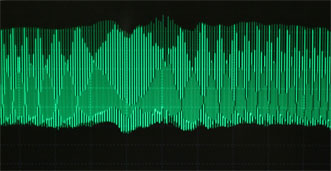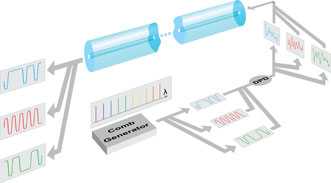SAN DIEGO, June 25, 2015 — Frequency combs could eliminate the need for repeaters, which are necessary for maintaining signals over long distances in today's fiber optic networks.
Developed at the University of California, San Diego, a patent-pending approach using frequency combs presents a potential solution to a long-standing roadblock to increasing fiber transmission rates: Beyond a threshold power level, additional power irreparably distorts the information.

A wideband frequency comb ensures that crosstalk between multiple communication channels within the same optical fiber is reversible. Courtesy of the University of California, San Diego, Photonics Systems Group.
"Today's fiber optic systems are a little like quicksand," said Nikola Alic, a research scientist at the university's Qualcomm Institute. "With quicksand, the more you struggle, the faster you sink. With fiber optics, after a certain point, the more power you add to the signal, the more distortion you get, in effect preventing a longer reach. Our approach removes this power limit, which in turn extends how far signals can travel in optical fiber without needing a repeater."
In laboratory experiments, the researchers successfully deciphered information after it traveled a record-breaking 12,000 km through fiber optic cables with standard amplifiers and no repeaters.
The experiments involved silica fiber optic cables with three and five optical channels and signals amplified up to 20 times. The researchers said their approach could be used in systems with far more channels. Most of today's fiber optic cables include more than 32 channels.

Predistorted waveforms are imprinted on frequency-comb-originating carriers in the data predistortion (DPD) block. The information is fully restored at the output of the optical fiber, which is free from the nonlinear crosstalk. Courtesy of the University of California, San Diego, Photonics Systems Group.
Electronic regeneration in modern lightwave transmission dictates the cost and, more importantly, prevents the construction of a transparent optical network. As a result, eliminating periodic electronic regeneration would drastically change the economy of the network infrastructure, ultimately leading to cheaper and more efficient transmission of information, the researchers said.
Frequency combs ensure that crosstalk between the different channels in a fiber is predictable and, therefore, reversible at the receiving end of the fiber.
"Our approach conditions the information before it is even sent, so the receiver is free of crosstalk caused by the Kerr effect," said professor Stojan Radic.
The work was published in Science (doi: 10.1126/science.aab1781).
For more information, visit www.ucsd.edu.